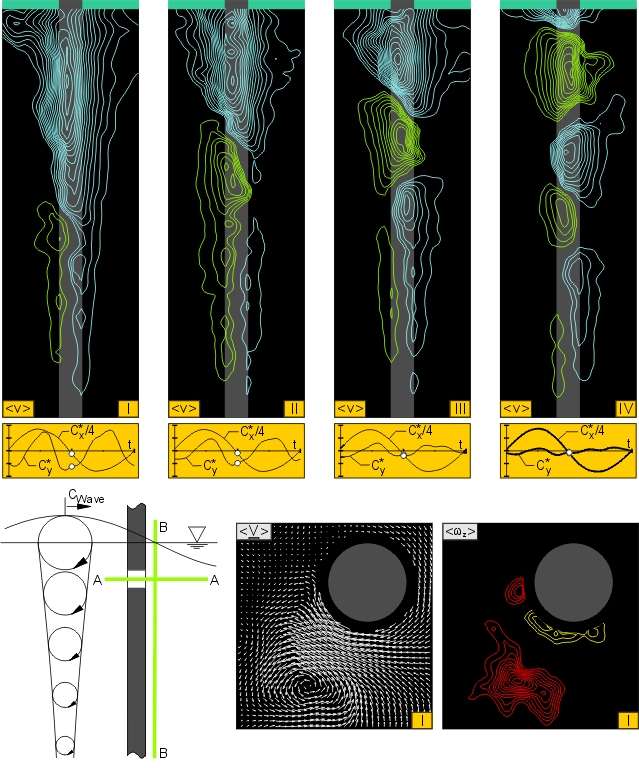You are here
Home ›Deep Water Wave Interaction with a Vertical Cylinder
Deep water wave interaction with a vertical cylinder. A deep-water wave with orbital particle trajectories interacts with a vertical cylinder as shown in the schematic. The images at the lower right represent patterns of phase-averaged velocity vectors <V> and vorticity <ωz> in the horizontal plane A-A. The corresponding three-dimensional pattern along the span of the cylinder, taken over a plane corresponding to the laser sheet B-B, is shown in image I at the top left. It shows contours of constant phase-averaged horizontal velocity ; the green lines correspond to positive values. Time histories of the moment coefficients due to the in-line force Cx*/4 and the transverse force Cy* show that the value of Cy* is relatively large due to the unidirectional pattern of <v> over the upper half of the image I. This reference pattern of image I competes with spontaneously excited patterns represented by images II, III and IV, which show three-dimensional distortions of decreasing wavelength. These distortions generate successively smaller values of moment coefficient Cy* due to the transverse force. KC = UmT/D = 12; S = fD2/n =164.
A vertical cylinder is located in a free-surface wave, and a two-camera version of high-image-density particle image velocimetry is employed to characterize the spanwise modes of the flow structure in terms of instantaneous velocity and vorticity. These modes are classified according to organized patterns of velocity in the near-wake, and are further interpreted in terms of distinctive arrangements of streamwise vorticity concentrations.
At low Keulegan-Carpenter number, which corresponds to small wave height, locally two-dimensional vortices having small scale and circulation tend to form as a symmetrical pair and remain attached, or in close proximity, to the surface of the cylinder. Along the span of the cylinder, the near-wake shows either a sinuous S or a unidirectional U mode. The spanwise wavelength l of the S modes, relative to the cylinder diameter D, lies in the range 1 < l/D < 4.5. These values of l/D represent the spacing between extrema of patterns of crossflow velocity, as well as between clusters of streamwise vorticity of like sign. As the free-surface is approached, the value of l/D scales with the ratio of the minor to major axis of the elliptical particle trajectory of the wave.
At moderate values of Keulegan-Carpenter number, locally two-dimensional vortices having large scale and circulation are shed from the cylinder in an asymmetric arrangement. The corresponding spanwise mode represents the phase variation of this shedding along the span of the cylinder. These sinuous S modes involve large-scale distortions of patterns of both crossflow velocity and streamwise vorticity, which have wavelengths in the range 10 < l/D < 110, in contrast to the spacing between individual concentrations of vorticity, which is 1.5 to 4D. Remarkably, it is possible to attain a unidirectional U mode, whereby the phase of the locally two-dimensional vortex shedding is preserved along the entire extent of the cylinder.
Signatures of the moments due to the transverse and in-line forces on the cylinder were acquired simultaneously with the aforementioned patterns of instantaneous velocity and vorticity. Severe modulations of the moment due to the transverse force are associated with spontaneous transformations between basic forms of the sinuous S and unidirectional U modes. The overall form of the signature of the moment due to the in- line force is, however, not generally affected by the spontaneous transformation between modes, but distortion of its peaks is evident.

